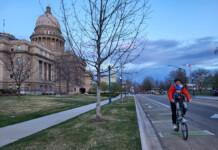By Katie Harrington
The Open Streets Project – an initiative that temporarily closes city streets to automobile traffic in order to promote walking and bicycling – is coming to Salt Lake City (SLC) on May 4 as part of the city’s Year of the Bike efforts.
Open Streets originated in Bogotá, Colombia as the Ciclovía – meaning bicycle pathways – more than 30 years ago. The Ciclovía continues to transform more than 70 miles of city streets into car-free pathways that promote bicycling, walking, skating, jogging, yoga, and acrobats for more than 2 million citizens who utilize the event every Sunday.
Bogotá’s festivities have inspired similar events to take place all over the world – from Brussels to Baltimore – in order to promote alternative forms of transportation, physical activity, and a sense of community.
Salt Lake City’s Plans
Bike Utah and Salt Lake City’s Transportation Division are hosting the Salt Lake City Open Streets event with help from community volunteers.
The event, named Open Streets Salt Lake City – Ci.SLC.lovia, will feature various programs, activities, and informational booths along a 1.5 mile route, said Colin Quinn-Hurst, the city’s sustainable transportation specialist who is helping to coordinate the event.
From 10 AM to 2:30 PM, automobile traffic will be closed along 300 South/Broadway between 600 West and 200 East, and on 200 East between 300 South and 400 South, Quinn-Hurst said.
The route will connect to two other events that will be going on downtown that day – the LiveGreen Festival and the Tour de Brewtah – and will promote local businesses that reside on those streets.
The LiveGreen Festival will take place at Library Square and will feature sustainable food and products, services and ideas, and music and entertainment.
The Tour de Brewtah is a cycling tour of the city’s breweries. The event will feature three different bicycle routes that each start and end at the Gallivan Center, but visit different breweries along the way.
“Opening our streets will be good for health, good for business, and community-building as well,” Quinn-Hurst said.
The Open Streets Project
The Open Streets Project in North America began in 2010 as a collaboration between the Alliance for Biking & Walking and the Street Plans Collaborative.
The project has seen success with more than 80 documented initiatives thus far, each of which has helped promote environmental, social, economic, and public health awareness, according to the project’s website.
A 2011 survey following an Open Streets event in St. Louis noted that 100 percent of the people in attendance thought the event strengthened their community, 94 percent felt that the event improved their feelings about the city, and 99 percent said the event welcomed everyone.
A recent study conducted by scientists at Georgia State University found that the combination of Ciclovía events and the existence of bike lanes in Bogotá, Colombia increased physical activity, community trust, and social participation.
“The Ciclovia and [bike lane] programs have the potential to equitably promote physical activity and provide a mobility alternative in complex urban settings such as Bogotá,” the study said.
Open Streets events also promote local businesses. In St. Louis, 73 percent of people spent money at a restaurant or store along the route and 68 percent of people became aware of a businesses that they had not been aware of before the event.
Quinn-Hurst said the city’s hope for Open Streets in Salt Lake City is to get as many people walking and biking on the street as possible, which will promote active lifestyles, supporting local, and being part of a community.
For more information about Open Streets in Salt Lake City or generally, visit www.bikeslc.com and openstreetsproject.org . For more on the LiveGreen Festival, visit livegreenslc.com. For more on the Tour de Brewtah, visit tourdebrewtah.org.
Katie Harrington on Google Plus








